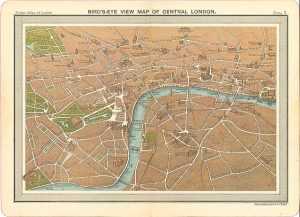Preserving Maps and Manuscripts
 [This information is taken from The Library of Congress. For more advice, see Caring for Your Book Collection.]
[This information is taken from The Library of Congress. For more advice, see Caring for Your Book Collection.]
The manufacturing method and materials of works on paper, such as the inks, paints and paper components, influence the inherent, long-term stability of library, art and archival items. Providing a good environment, and safe handling and storage conditions are critical to preserving paper collections.
Relative humidity and temperature:
Store paper materials in dark, cool, relatively dry locations. Aim for 35% relative humidity and below 72° F. Avoid light, heat and dampness. Maintaining steady temperature and relative humidity is preferable over conditions that cycle up and down. Attics, bathrooms and basements are generally to be avoided. Inside walls are drier than outside walls, where moisture can collect. High humidity can lead to the development of foxing (small brown disfiguring spots in paper) or mold growth. Vigilance is necessary to ensure maintenance of acceptable environmental conditions.
Lighting:
Most paper items are susceptible to damage from ultraviolet (UV) and visible light. UV radiation, which is emitted by the sun and fluorescent bulbs, is particularly damaging to paper items. If UV is present, it should be eliminated by using a filtering glazing in frames, or filters over windows and light bulbs. The intensity and length of exposure to visible light on paper items should be reduced as much as possible. Particularly light sensitive items such as watercolors, manuscripts, newsprint and non-print media should be stored away from the light as much as possible to avoid fading and/or yellowing. Close drapes and hang pictures on inside walls away from sunlight and long term lighting. In some cases framing a photocopy or photograph of an original item will be a good substitute for exposing the sensitive original to light damage.
Pollution, Dust, and Pests:
Pollutants, such as ozone and fumes from photocopy machines, car exhausts, and heating systems can cause damage to paper and media. Alkaline storage materials can help provide a buffer to these airborne pollutants. Paper materials should be protected from dust and dirt. Monitor for evidence of rodents and insects, such as silverfish, book lice and book worms, which can eat, soil and damage paper; good housekeeping and environmental conditions will help reduce the threat of these pests.
Storage:
It is best to store paper items flat, rather than folding and unfolding, which can lead to creases and tears. Seek the advice of a paper conservator, if any trouble is encountered when unfolding or unrolling an object.
Paper materials may be stored in acid-free alkaline folders, polyester film folders or alkaline mats. Alkaline paper or board provides a desirable neutralizing effect on acidity. The stiffness of the storage folder or box should provide adequate support to the item(s) in storage and transport. Since acidity migrates, acidic storage materials should be avoided, and highly acidic materials, such as newspaper clippings or telegrams should be isolated to avoid acid migration. Polyester film has the benefit of being clear and can also provide support, but is not alkaline. Polyester film can have an electrostatic charge which will cause damage to friable media such as unfixed pastel and charcoal, heavily applied pencil, and flaking media.
Handling paper materials:
Hands should be clean and dry before handling paper items, as the oils from fingers can cause staining on the paper.
Avoid having food or drinks in the area of your collection.
Use pencils when working with your collection, to avoid possible disfigurement from inks.
Damaged Paper Items:
If a paper item becomes damaged, place it in a folder and contact a paper conservator, who can provide the treatment needed.
Avoid using pressure-sensitive tapes (including those called “archival”) as they can cause irreversible disfigurement, embrittlement of paper and alteration of inks.
If a flat paper item becomes moldy or wet, isolate it from other materials and dry it with warm circulating air. Contact a paper conservator for further advice.
To select the professional best qualified to treat your object, contact the referral service maintained by The Foundation of the American Institute for Conservation (FAIC). They will provide you with a list of conservators in your area that can help you find an appropriate conservator or conservation treatment:
The Foundation of the American Institute for Conservation (FAIC)
1717 K Street, NW, Suite 301
Washington, D.C. 20006
Telephone (202) 452-9545
FAX (202) 452-9328
Further Reading:
Ellis, Margaret Holben. The Care of Prints and Drawings .
Nashville: American Association for State and Local History, 1987.
National Committee to Save America’s Cultural Collections. Caring for Your Collections.
New York: Harry N. Abrams, Inc., 1992.
Ritzenthaler, Mary Lynn. Preserving Archives and Manuscripts.
Chicago, Il: Society of American Archivists, 1993.
The preservation procedures described here have been used by the Library of Congress in the care of its collections and are considered suitable by the Library as described; however, neither the operators of this website nor the Library will be responsible for damage to your collection should damage result from the use of these procedures.